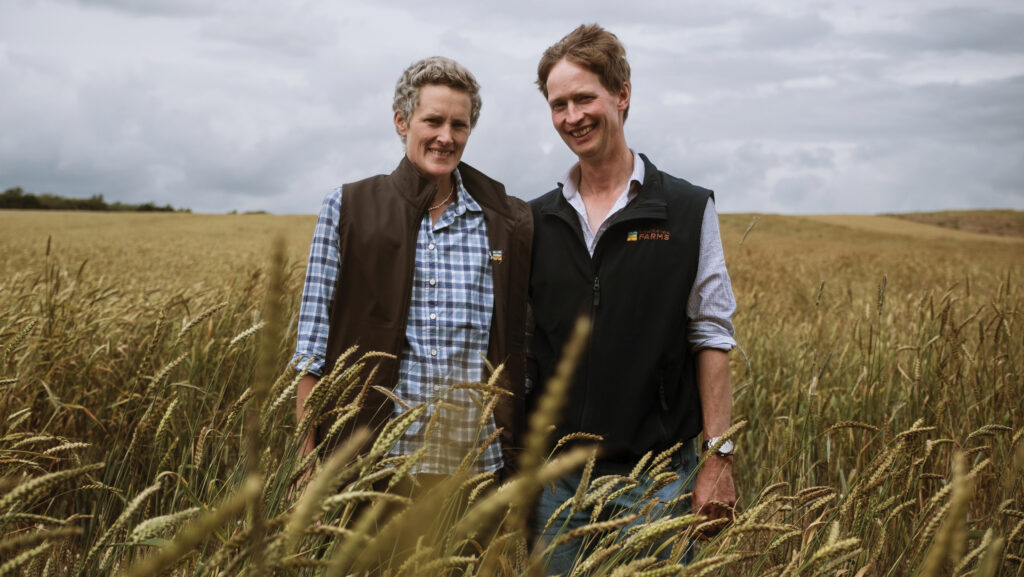Cover crop trial reveals impact of grazing on nitrates
 Emma and James Loder-Symonds © MAG/Colin Miller
Emma and James Loder-Symonds © MAG/Colin Miller Since winning the title of Farmers Weekly Environmental Farmers of the Year, Emma and James Loder-Symonds have been busy trialling the impact of grazing cover crops.
The cover crop trial took place in conjunction with Southern Water, AHDB and FWAG South East.
It involved establishing a crop of kale, stubble radish, linseed, red clover and phacelia in late August after harvest, which was then overwintered and grazed from 1 November.
See also: Drill change improves cereal crop resilience
James explains: “The crux of the trial was looking at whether grazing cover crops earlier than 15 January has a detrimental impact on their ability to reduce nitrate leaching.
“And if cover crops can be grazed earlier than 15 January, what does good management look like in terms of timing, stocking density and grazing regime?”
The trial was carried out over 18 days in total. “There were four 4.5ha plots in total – a fallow plot, a plot with a cover crop, one which was set stocked (100 sheep on 4.5ha) and grazed by sheep, and another which was mob grazed with sheep which were moved every day (50 sheep on 0.5ha/day).”
Key findings
“We looked at filtration levels, tissue analysis and moisture retention and found that the cover crop retained more nitrates than the fallow plot,” James explains.
“Both grazing approaches appeared to increase soil nitrates compared with the cover crop control.”
The couple employed a grazier for the trial. James says: “We all know about the benefits of cover crops, but I think having a grazier who understands what we’re trying to achieve in soil health, our ethos and ideology, is key – not just grazing it to the ground.
“Mob grazing is ideal because it leaves a living root, so it is still a growing plant, but it is time-consuming.”
Looking ahead, the couple are doing further work on nitrogen efficiency, he says.
“We’re working with Messium to improve the efficiency of nitrogen on wheat crops, taking satellite imagery and ground truthing it with tissue analysis.
“Our whole desire is to keep pushing the boundaries and not just accept the norm for the norm.”
Hedge laying
Hedge laying is something Emma and James are passionate about, and each year, along with the farm team, they plant about 1km of hedges – which began initially thanks to local expert, Michael White.
“Michael had been laying our hedges for a few years and he got us into it, He’s now running a beginners’ course at the farm,” says James.
“It’s about increasing the number of people who will take that skill on, and from a habitat point of view we need to lay more hedges.
“Hedge laying is also important for the longevity of the hedge; the benefit will last for at least 20 years before it needs to be laid again.
“From a wildlife perspective a laid hedge gives a thicker canopy – so for birds nesting, it helps reduce predation. It also offers a safe haven for connectivity from one habitat to another,” he explains.
“It also improves carbon capture, and ultimately can make fields stockproof, if managed properly.”
The couple have noticed an increase in bird numbers since planting the hedges.
“We have two ex-RSPB ringers who come and do bird surveys, as well as our Natural England adviser, so we have records to prove that bird numbers are increasing,” says James.
“We have wild bird mixes which provide supplementary feed, and we have seen a particular increase in yellowhammer numbers.”
This also has an educational aspect. “When we have school visits they get a lot out of seeing the wildlife,” says James.
“Emma is a teacher and she spearheads the educational side of the farm; we have over 1,500 people through the gates every year.
“It’s all about getting people to understand nature and where their food comes from – ultimately why they should care about the countryside and buy British.”
James acknowledges the impact of the Countryside Stewardship scheme. “It has increased payments for planting and laying hedges, which does help.”
So what does the ideal hedge look like? “It varies from region to region, but for us, having hawthorn, dog rose, rosehips and hazel provide a habitat and a food source for the winter.”

